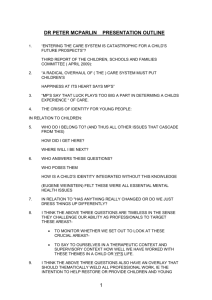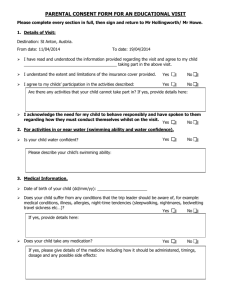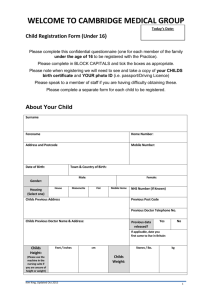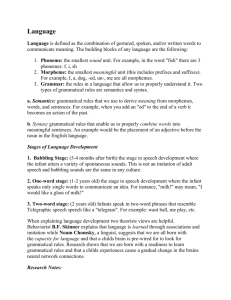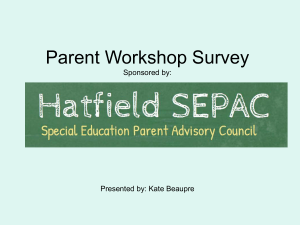CG 87Syllabus`06
advertisement
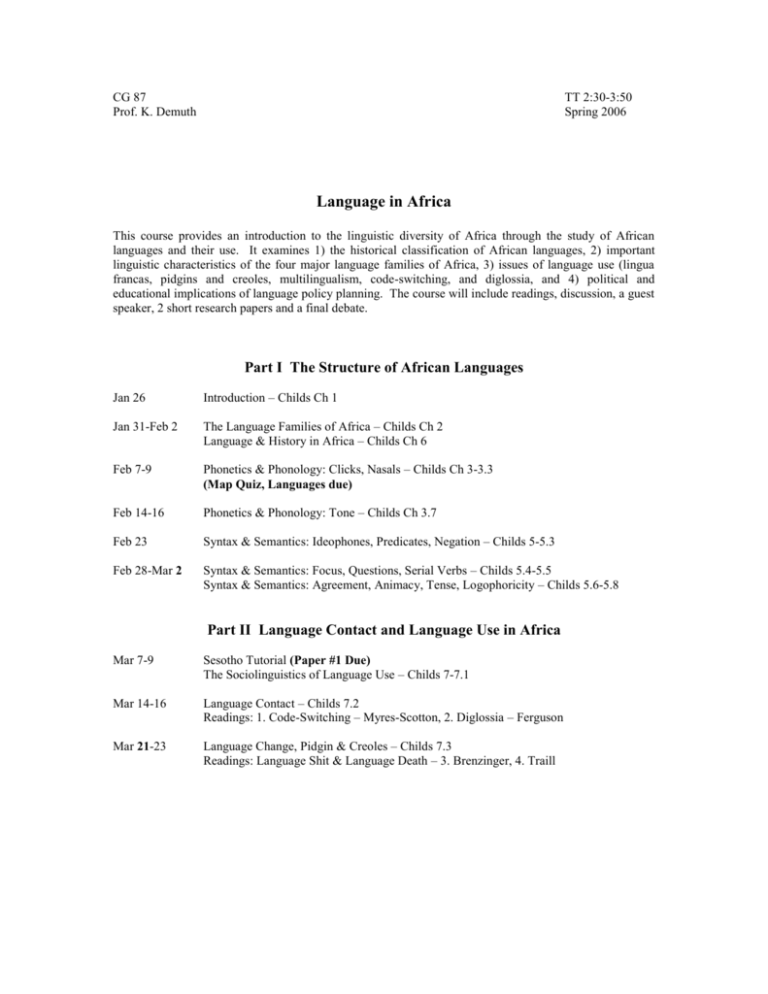
CG 87 Prof. K. Demuth TT 2:30-3:50 Spring 2006 Language in Africa This course provides an introduction to the linguistic diversity of Africa through the study of African languages and their use. It examines 1) the historical classification of African languages, 2) important linguistic characteristics of the four major language families of Africa, 3) issues of language use (lingua francas, pidgins and creoles, multilingualism, code-switching, and diglossia, and 4) political and educational implications of language policy planning. The course will include readings, discussion, a guest speaker, 2 short research papers and a final debate. Part I The Structure of African Languages Jan 26 Introduction – Childs Ch 1 Jan 31-Feb 2 The Language Families of Africa – Childs Ch 2 Language & History in Africa – Childs Ch 6 Feb 7-9 Phonetics & Phonology: Clicks, Nasals – Childs Ch 3-3.3 (Map Quiz, Languages due) Feb 14-16 Phonetics & Phonology: Tone – Childs Ch 3.7 Feb 23 Syntax & Semantics: Ideophones, Predicates, Negation – Childs 5-5.3 Feb 28-Mar 2 Syntax & Semantics: Focus, Questions, Serial Verbs – Childs 5.4-5.5 Syntax & Semantics: Agreement, Animacy, Tense, Logophoricity – Childs 5.6-5.8 Part II Language Contact and Language Use in Africa Mar 7-9 Sesotho Tutorial (Paper #1 Due) The Sociolinguistics of Language Use – Childs 7-7.1 Mar 14-16 Language Contact – Childs 7.2 Readings: 1. Code-Switching – Myres-Scotton, 2. Diglossia – Ferguson Mar 21-23 Language Change, Pidgin & Creoles – Childs 7.3 Readings: Language Shit & Language Death – 3. Brenzinger, 4. Traill Part III Language Policy and Language Planning Apr 4-6 Language and National Integration – Bamgbose Ch 1 (Paper #2 due) Language, Communication & National Development – Bamgbose Ch 2 Apr 11-13 Language and Education – Bamgbose Ch 3 Language Planning – Bamgbose Ch 4 Apr 18-20 Language Planning: Readings 5. Heine, 6. Hartshorne Planning: Sociolinguistics, South Africa: Readings 7. Eastman, 8. Heugh Apr 25-27 South Africa: PanSLAB, Guest Speaker (Debate position papers due) Debate Texts Bambose, A. 1991. Language and the Nation. Edinburgh: Edinburgh University Press. Childs, G. T. 2003. An introduction to African Languages. Amsterdam: John Benjamins. Readings 1. Myres-Scotton, C. 1992. A model of the social functions of code selection. In R. Herbert (ed.). Language and Society in Africa. Johannesburg: Witwatersrand Univ. Press. ppl. 165-180. 2. Ferguson, C. A. 1972. Diglossia. In Pier Paolo Giglioli, Language and Social Context. pp. 232-251. New York, NY: Penguin Books. [Reprinted from Word 15: 325-40, 1959.] 3. Brenzinger, M. 1992. Patterns of language shift in East Africa. In R. Herbert (ed.). Language and Society in Africa. Johannesburg: Witwatersrand Univ. Press. pp. 287-304. 4. Traill, A. 1995. The Khoesan languages of South Africa. In R. Mestrie, (ed.). Language and Social History. Cape Town: David Philip. pp. 1-18. 5. Heine, B. 1992. Language Policies in Africa. In R. Herbert (ed.). Langauge and Society in Africa. Johannesburg: Witwatersrand Univ. Press. pp. 23-36. 6. Hartshorne, K. 1995. Language policy in African education: A background to the future. In R. Mestrie, (ed.). Language and Social History. Cape Town: David Philip. pp. 306-318. 7. Eastman, C. 1992. Sociolinguistics in Africa: Language planning. In R. Herbert (ed.). Language and Society in Africa. Johannesburg: Witwatersrand Univ. Press. pp. 95-114. 8 Heugh, K. 1995. Disabling and enabling: Implications of language policy trends in South Africa. In R. Mestrie, (ed.). Language and Social History. Cape Town: David Philip. pp. 329-350. Grade: 1/3rd 2/3rds Class Discussion, Map Quiz, Debate 2 Research Papers
